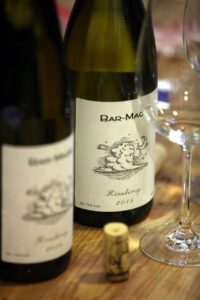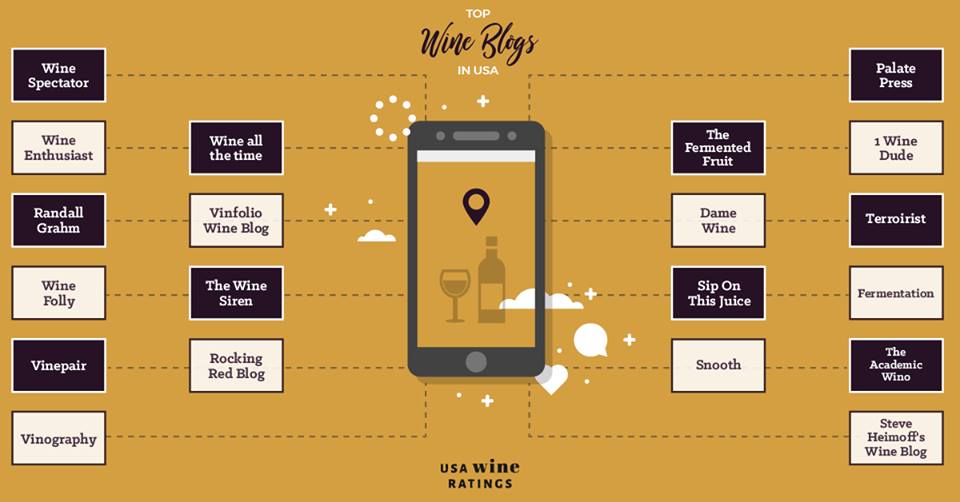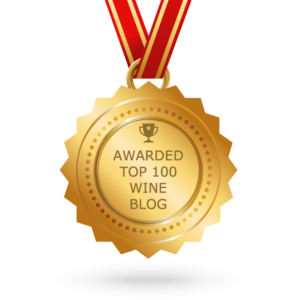Two Riesling wines from the same producer sat before me – a 2014 and a 2015 – yet they had two different bottle shapes. I was told by the producer that the reason for the difference is because Israel is perceived to be surrounded by “enemies” so everything is extremely expensive to import, especially if one needs it within a couple of days. I was talking to one of the most fascinating wine producers I have ever met – Rami Bar-Maor, owner and winemaker for Bar-Maor, a winery in the Shomron, southern Mount Carmel area (although Rami takes issue with these names as a regional wine designation). Rami actually disagrees with this perception and does not believe in the concept of enemies – he expressed his discontent at even the notion of such an idea.
Rami is a man who deeply thinks about every nuance of everything, who was forced to accept a different bottle for his 2015 Riesling because he could not get the bottle he wanted, and he talked about his uneasiness of such a predicament saying, “I can’t do anything without any context… everything needs a reason and doing something without meaning is very bad.”
 Before we arrived at his facility, I was told that Rami wanted us to excuse its outside appearance – his winery is not a beautiful château-style building, but is located in an industrial park. But as I walked through an alley between the metal clad buildings, a twinge of excitement shot up my back… I had a feeling that I was about to experience a winery visit like no other. The first thing I saw when I walked into the winery was a huge table with various meats, cheeses, breads, and lots of bottles lined up in multiple verticals; information about the winery lined up on a perfect angle with metals clips that were each exactly the same distance from the top and bottom. Everything on that table was placed in a certain way and organized according to an overall concept. At that moment, I knew I was about to meet a very unique individual.
Before we arrived at his facility, I was told that Rami wanted us to excuse its outside appearance – his winery is not a beautiful château-style building, but is located in an industrial park. But as I walked through an alley between the metal clad buildings, a twinge of excitement shot up my back… I had a feeling that I was about to experience a winery visit like no other. The first thing I saw when I walked into the winery was a huge table with various meats, cheeses, breads, and lots of bottles lined up in multiple verticals; information about the winery lined up on a perfect angle with metals clips that were each exactly the same distance from the top and bottom. Everything on that table was placed in a certain way and organized according to an overall concept. At that moment, I knew I was about to meet a very unique individual.
Bikat-Hanadiv
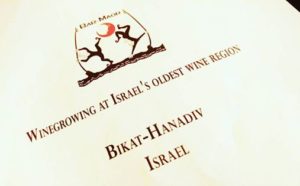 It took no time to figure out that Rami was meticulous, with everything having an intention – a purpose. He was constantly striving to improve, to reach an ideal… even if he was limited in resources and opportunity, he was not giving up. He has not only given careful attention to his vineyards and cellar, but he has also brought his knowledge and experience to other wineries in the area and strongly believes that they can come together to raise the quality and image of their region overall.
It took no time to figure out that Rami was meticulous, with everything having an intention – a purpose. He was constantly striving to improve, to reach an ideal… even if he was limited in resources and opportunity, he was not giving up. He has not only given careful attention to his vineyards and cellar, but he has also brought his knowledge and experience to other wineries in the area and strongly believes that they can come together to raise the quality and image of their region overall.
There are many issues that Rami has to contend with… one being a name for the region. Many refer to the area as Mount Carmel, although many vineyards have nothing to do with that mountain. The three largest commercial producers in the area cannot agree on a name for their area and Rami believes that the little guys, like himself, should leave the quarreling between the big companies and that they should decide a name for themselves.
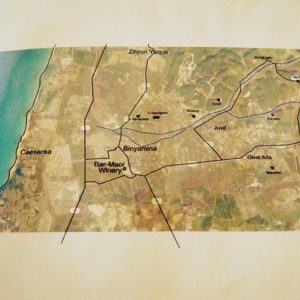 Bikat-Hanadiv (translates into “Generous Valley” and said to be one of the oldest wine growing areas in Israel) is the name that he gave his area. He examined the areas that had the same sense of place, aka terroir, and drew lines based on that idea – leaving out historical or political persuasion. Only a couple of months ago, he delineated this wine growing area calling it Bikat-Hanadiv, and gathered 13 wineries – all of them having at least 85% of their land in this designated area – although 4 of these wineries do not have their production facilities there but they have at least 85% of their vineyards within the boundaries.
Bikat-Hanadiv (translates into “Generous Valley” and said to be one of the oldest wine growing areas in Israel) is the name that he gave his area. He examined the areas that had the same sense of place, aka terroir, and drew lines based on that idea – leaving out historical or political persuasion. Only a couple of months ago, he delineated this wine growing area calling it Bikat-Hanadiv, and gathered 13 wineries – all of them having at least 85% of their land in this designated area – although 4 of these wineries do not have their production facilities there but they have at least 85% of their vineyards within the boundaries.
Rami has been working with his neighbors, as well as his own vineyards, to produce fruit that is complex, naturally high in acid and moderate in alcohol, with structure. They have a high water table in Bikat-Hanadiv and so he does not believe in irrigation. Also, he is a proponent of early “harsh” pruning and stopping other “procedures” (more pruning, tipping the ends, green harvesting) later in the season to find more balance in their area. There are many other concepts that he has implemented in the vineyards, I can’t share them all in one post, but the idea is to stop using what everyone else is doing in Israel and focus on their specific area and make adjustments and alterations accordingly.
Rami said that for his first three years as a producer, he bought a small percentage of grapes from the Golan Heights, a well-known wine producing area in northern Israel, but he realized that he needed to completely invest his time, study and energy into Bikat-Hanadiv and he is “working like hell” to show the “true potential here” by no longer using grapes from any other region than his own. He further added that they had a long way to go, but they have to start somewhere to talk about the region; from this time forward he is adding the name “Bikat-Hanadiv” to his label although it is not a legally defined term so it is illegal to do so.
Rami Bar-Maor
Orignally, Rami Bar-Maor was an architect who became frustrated by the compromises he was forced to make – so the end result never lived up to his concept and ideal. He was involved in designing a section of Habima Square, a famous public space in the center of Tel Aviv, but the end result did not meet his standards and, today, is still painful for him to look at. Rami, a soft-spoken man, has a great inner intensity with a conscientious desire to improve the world in which he lives.
As a frustrated architect obsessed with creating excellence, he ended up getting into winemaking, interning at the renowned Margalit Winery – many consider Dr. Yair Margalit a genius who wrote one of the preeminent books on wine chemistry. Others in the wine industry told Rami to work at a bigger winery where he could learn more, but once he learned that Margalit made wines in a “primitive way,” he knew that it would fit his minimalist ideal of allowing the grapes to show their true nature.
Rami believes in primitive ways, using knowledge and research to back it up, to express the nature and sense of place of his vineyards. He does not allow acid corrections, uses free run juice only, with no pressing at all for his reds (he only has one white – Riesling), no filtration, no clarification, and relies on winter rains rather than the use of irrigation. Many think he is mad for trying such practices in a climate that has such high amounts of heat and sunlight, yet he is making it work.
Transparency of Purpose
Rami openly admits that not everything is ideal in his winery, but at least has the intention to improve, to express a true sense of place, and he is working everyday with his neighbors to bring a deep meaning and high quality to his region’s wines. At one point I was overwhelmed with an incredible sense of honor to sit in the presence of someone who had everything against him, yet was not going to stop doing what he thought was right.
I know that many years from now, this will be one of the encounters that I will look back on and say to myself, “Wow, I got to meet someone who planted seeds to change the wine world into a more thoughtful, transparent place.” The only thing that is unknown to me is if he will ever get the adulation that he so rightly deserves, or will he be one of the unsung heroes that helped to bring a real sense of place to the Israeli wine industry that no one in the international community ever hears of. I have a feeling that Rami’s purpose will be served simply if Bikat-Hanadiv is recognized for their unique place and high quality wines… he has very little need for personal celebrity. Either way, I am profoundly grateful to have met someone who truly lives by his elevated ethical principles.
***********************
Bar-Maor Wines Tasted on February 2nd, 2017
***Bar-Maor wines are not, as of yet, imported into the US and they are non-kosher, but I hope to see them in New York City someday soon.
Production is around 15,000 bottles a year.
I have added a lot of side information before the tasting notes of each vertical because Rami thinks about every little thing that is involved in all aspects of being a wine producer and loves to share his mindset and process… I have only shared a small portion of what I have learned from him. Feel free to read everything or jump to the tasting notes.
On most of the labels of the current vintages, Rami uses the word “Rendzina” – the name of the free, eroded white chalky soil – a Polish word that means “to chat”. When a person walks through the Bikat-Hanadiv vineyards, it sounds like there is someone else there. Rami says the free, decomposed chalky soil has a different chemical reaction with the vegetation than the bounded chalk that looks like crystals.
===========================================
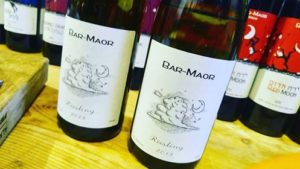 Rami believes that whites need a lot more caring than reds, and although they are not in Germany where Riesling originates, he wanted to try it in his area of Bikat-Hanadiv to see if it was possible to create an elegant Riesling. He had problems in 2015: I found the wine tasty, but it is not to his ideal, but he accepts that he doesn’t have control over vintage variation. Also, Rami notes that Riesling will get into stress very early in the season, and so, avoiding tropical fruit flavors is a challenge for him.
Rami believes that whites need a lot more caring than reds, and although they are not in Germany where Riesling originates, he wanted to try it in his area of Bikat-Hanadiv to see if it was possible to create an elegant Riesling. He had problems in 2015: I found the wine tasty, but it is not to his ideal, but he accepts that he doesn’t have control over vintage variation. Also, Rami notes that Riesling will get into stress very early in the season, and so, avoiding tropical fruit flavors is a challenge for him.
The last note about the Riesling, before the tasting notes – he leaves a block of oak in the tank to provide oxygen to the yeast because it is fermenting in very low temperatures and may create hydrogen sulfide – the odor of rotten eggs.
-2014 Riesling: Flinty minerality, lime blossom, smoky with nice backbone of acidity with a linear edge.
-2015 Riesling: Key limes and juicy peach with riper flavors due to the hotter year but still has a fresh quality.
==========================================
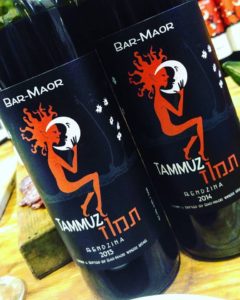 The next wine is Tammuz (Summer Blend, aka a wine to drink during the hot Israeli summers) and the label represents the forces of nature: red blend around 60% Merlot, 28% Cabernet Sauvignon and 12% Marselan – based on 2014. Rami believes that the flavors in this wine should not last too long… they should come and leave quickly – which, in his mind, is perfect for summer.
The next wine is Tammuz (Summer Blend, aka a wine to drink during the hot Israeli summers) and the label represents the forces of nature: red blend around 60% Merlot, 28% Cabernet Sauvignon and 12% Marselan – based on 2014. Rami believes that the flavors in this wine should not last too long… they should come and leave quickly – which, in his mind, is perfect for summer.
Since Rami has an architect’s background, he has a concept for each wine in his head. The Tammuz should be very lovely, the drinker should watch it move up in the air, watch it move along and then, all of the sudden, look up at it again and it is no longer there – it has vanished completely… like star dust. It should not stay in the mouth too long. He says he is not there yet, but is almost there with this wine.
-2013 Tammuz: This was the first attempt at this concept with firm texture yet is still playful with bursts of blackberry, a touch of cinnamon and a clean finish.
-2014 Tammuz: The ‘14 is rounder and closer to what Rami wants as it dances across one’s palate – youthful and expressive and hasn’t been weighed down by life.
============================================
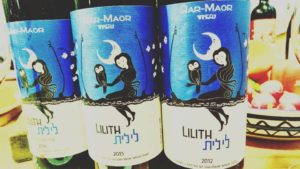 The woman on this label is Lilith. Some think of her as the black demon, who had 1000 baby demons with the devil. The story goes that she was Adam’s first wife but she was complete on her own because she was human born and did not come from his rib like Eve. She was born for her own enjoyment. Others consider her to be the first feminist… and that’s perhaps why some may find her dark. Rami loves Syrah and he is a big believer of growing it in his area – Bikat-Hanadiv. He says it is dark and “dirty” but dirty in a way that people enjoy – it is the siren that people know they should avoid but cannot deny.
The woman on this label is Lilith. Some think of her as the black demon, who had 1000 baby demons with the devil. The story goes that she was Adam’s first wife but she was complete on her own because she was human born and did not come from his rib like Eve. She was born for her own enjoyment. Others consider her to be the first feminist… and that’s perhaps why some may find her dark. Rami loves Syrah and he is a big believer of growing it in his area – Bikat-Hanadiv. He says it is dark and “dirty” but dirty in a way that people enjoy – it is the siren that people know they should avoid but cannot deny.
Lilith is a red blend of about 75% Cabernet Sauvignon and 25% Syrah – based on 2014. Rami says Lilith has “too much” of everything inside.
-2012 Lilith: There is this dark earthiness with lush texture that sucks one into this wine, yet it has a good backbone of structure and acidity with tannins that keeps one guessing.
-2013 Lilith: I felt this vintage had more pretty fruit notes like cassis in the beginning but then there were animalistic tendencies on the finish, and the tannins hook you at the end.
-2014 Lilith: Meaty, charming and funky notes made this wine so much fun, plenty of fruit to keep you hooked with the intense savory, wild qualities. The big, round tannins seems to first gently invite one in, then they become unexpectedly rough and beat you up… but there is always the urge to go back for more.
===========================================
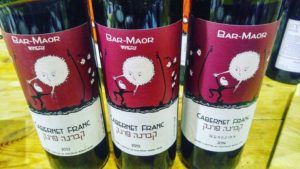 The label for Bar-Maor’s Cabernet Franc is based on a 1920s German graphic that shows the idea of humans being in control –we think we are in control, but we are not. Rami believes the same is true of vineyards – he surrenders to the fact that he doesn’t have control over them.
The label for Bar-Maor’s Cabernet Franc is based on a 1920s German graphic that shows the idea of humans being in control –we think we are in control, but we are not. Rami believes the same is true of vineyards – he surrenders to the fact that he doesn’t have control over them.
His Cabernet Franc gets the highest amount of new oak because he feels it can absorb it and naturally integrates it without losing its own distinct characteristics.
Rami feels Cabernet Franc divides Israeli customers into two groups: Those that hate Cabernet Franc or those that die for Cabernet Franc.
The Cabernet Franc is a blend of around 94% Cabernet Franc and 6% Merlot – based on 2014.
-2012 Cabernet Franc: Mingles a touch of dried herbs with spicy oak, fresh black raspberry fruit with fine, firm tannins that have a regal presence.
-2013 Cabernet Franc: Pretty, intense nose of raspberry with hint of blackcurrant leaves and more velvety tannins.
-2014 Cabernet Franc: Crushed stones and gravel with an intoxicating note of wild flowers and a good balance between structure and accessibility.
=====================================
The Red Moon is Merlot dominant with 2014 being the only one that is 100% Merlot. According to Rami the other vintages needed a little bit of green, and so that is why he added Cabernet Franc.
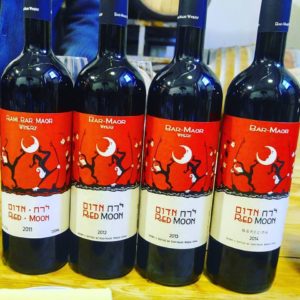 Originally, he had a single restaurant buy all of his Red Moon, but they kept telling him that they wanted it more subtle to pair with their antipasta, tomato based food. Rami told them that they needed to leave the Red Moon open, without a cork, for 4 days to have it settle down. They listened to him and the wine became more subtle and now goes perfectly with the food.
Originally, he had a single restaurant buy all of his Red Moon, but they kept telling him that they wanted it more subtle to pair with their antipasta, tomato based food. Rami told them that they needed to leave the Red Moon open, without a cork, for 4 days to have it settle down. They listened to him and the wine became more subtle and now goes perfectly with the food.
-2011 Red Moon: 2011 was the coolest season in several years. Sage and black raspberry with soft body. It was the first year he made Red Moon but it is very different from subsequent vintages since it was such a cool year in Israel.
-2012 Red Moon: Bright, expressive fruit with sour cherry (never got that on a Merlot dominant wine), lots of verve…invigorating!
-2013 Red Moon: Plums, dried leaves and wafting aromas of truffles on the finish.
-2014 Red Moon: 100% Merlot. This is an excellent effort, reminding me of some Pomerol wines such as Gazin…Supple and rich yet firm and elegant… opulent while remaining fresh and thrilling. I thought this wine, considering it is 100% Merlot, really showed that Rami is on the right track in his vineyards.
===========================================
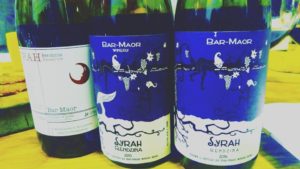 Rami said that the nature of Syrah is to become reductive… so he does not fight it. It took him time to figure out how to work with this variety. In order to reach complexity without jammy qualities, and seemingly high alcohol, he has to go to the “dark side” of the winery – placing a percentage of the wine in a reductive state in stainless steel. I have to say that I am really in love with his Syrah wines and can’t wait to see where he goes with them.
Rami said that the nature of Syrah is to become reductive… so he does not fight it. It took him time to figure out how to work with this variety. In order to reach complexity without jammy qualities, and seemingly high alcohol, he has to go to the “dark side” of the winery – placing a percentage of the wine in a reductive state in stainless steel. I have to say that I am really in love with his Syrah wines and can’t wait to see where he goes with them.
-2012 Syrah: Although the 2012 and 2013 did not meet Rami’s standards, I found them quite charming with all of the classic gamy, earthy notes that Northern Rhône wine lovers go orgasmic over, yet it had others qualities making it distinctly Bikat-Hanadiv. Hints of black tea and an intense backbone made this a heart-beat-faster sort of wine.
-2013 Syrah: I found this wine very “dark” with lots of brooding fruit and wet earth that was sensual in a rough sort of way.
-2014 Syrah: This was Rami’s favorite – he feels he is starting to understand how to grow and handle Syrah from Bikat-Hanadiv. This vintage had an exceptional balance of the dark and elegant qualities… wet stones, layers of dried and fresh currants and a hint of rosemary, lots of dry extract giving it shape and marked acidity that gave it an exciting finish… a wine that draws the drinker in again and again.
=====================================
Archetype Reserve, a red blend of Syrah, Carignan and Marselan, captures the quintessential essence of Bikat-Hanadiv.
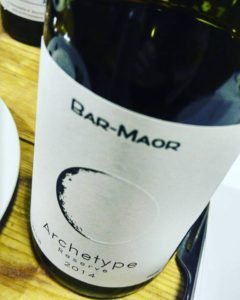 The Archetype (prototype of how wine should be made in Rami’s area: not leaning on oak, alcohol or fruit). Red blend of 55% Syrah, 35% Carignan (placed in stainless steel for one year then added to the blend) and 10% Marselan (brings a rim of black fruit to the blend).
The Archetype (prototype of how wine should be made in Rami’s area: not leaning on oak, alcohol or fruit). Red blend of 55% Syrah, 35% Carignan (placed in stainless steel for one year then added to the blend) and 10% Marselan (brings a rim of black fruit to the blend).
Only 1000 bottles produced.
-2014 Archetype Reserve: The first example of his ideal of not leaning on Bordeaux varieties has lower alcohol (13.5% abv) and spends less time in barrels – showing the potential of Bikat-Hanadiv. A deep ruby color that has that notes of dried meats, black cherries and black mulberries, coalescing with hints of tar and a stunning under-note of chalky minerality – juicy mid-palate with a superb length of flavor that finishes with star anise and wild herbs.

